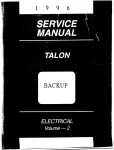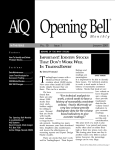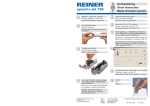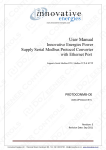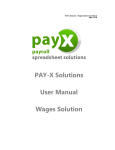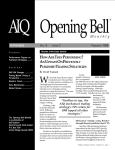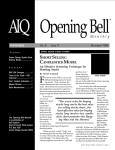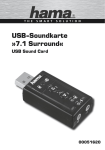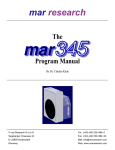Download Market Timing Expert Ratings - Year 2000
Transcript
AIQ Opening Bell Monthly IN THIS ISSUE Feature Backtesting AIQ's Market Timing Model ....................... 1 S ec t i o n s Data Maintenance ................ 3 Performance of Previously Published Strategies ........... 4 Market Review ...................... 6 Words of Wisdom ................ 7 S&P 500 Changes ................ 8 The Opening Bell Monthly is a publication of AIQ Systems David Vomund, Chief Analyst P.O. Box 7530 Incline Village, Nevada 89452 V OL . 10 I SSUE 2 F EBRUARY 2001 MARKET TIMING BACKTESTING AIQ MARKET TIMING FOR 2000 NOT PERFECT BUT BETTER THAN S&P 500 By David Vomund Y of the bad signals. DAVID VOMUND ear 2000 was a great year to The confirincorporate market timing. mation technique that most people In fact, a good market timer use utilizes the Price Phase indicawould have been out of the market tor. With this technique, a buy for a good part of the year! signal is not acted on until the Phase Throughout the year, the S&P 500 indicator increases. Conversely, a fell 10% and the only time the sell signal is not considered a sell overall market was strong was at until the Phase indicator decreases. the start of the As is the year. The AIQ case with all bad The 2000 return (for AIQ timing model signals, the outperformed model) was negative 5.14%. slower the the market in confirmation That compares to an S&P 2000 but it was 500 buy-and-hold return of indicator the far from perfect. better the re- negative 10% A historical sults. The backtest of the problem with market timing model reveals that too slow a confirmation technique, the highest returns come from however, is that most of the Expert simply using the market timing Rating signals are good. By applymodel without confirmation. That ing too slow of a confirmation, you is, you buy when an upside signal of buy/sell too late after a good signal 95 or greater is registered and you and overall returns are lower. sell when a downside signal of 95 or An example of this is found in greater is registered, using ticker Figure 1. On January 5, a 99 buy DJIA. The reason people use confir- signal was registered but the signal mation is that it helps to avoid some was not initially confirmed as the Market Timing Backtesting continued on page 2 ® AIQ Opening Bell MARKET TIMING BACKTESTING continued . . . Phase indicator was decreasing. The market rallied immediately after the signal and confirmation came two days later when the Phase indicator increased. Missing a two day rally isnt bad but when that happens several times in a year it can make a difference. Figure 1 The 2000 buy and sell signals are listed in Table 1. The results assume that you buy the S&P 500 on the day a buy signal of 95 or greater is registered, and you sell on the day a 95 or greater sell signal is registered. The 2000 return was negative 5.14%. That compares to an S&P 500 buy-andhold return of negative 10%. If you apply a Phase indicator confirmation to the market timing signals, the return becomes negative 13.57%. Nasdaq 100 Timing Model In the May 1999 issue of the Opening Bell, we introduced the concept of using AIQs regular market timing model on the Nasdaq 100 index. In review, AIQs market timing system needs price, breadth, and volume in its Expert System. The Nasdaq Composite has all of these but Nasdaq breadth isnt representative because it is calculated from too many small-cap issues that have no influence on the Compos- PLEASE SEND CORRESPONDENCE TO: Opening Bell Monthly G.R. Barbor, Editor P.O. Box 7530 Incline Village, NV 89452 AIQ Opening Bell Monthly does not intend to make trading recommendations, nor do we publish, keep or claim any track records. It is designed as a serious tool to aid investors in their trading decisions through the use of AIQ software and an increased familiarity with technical indicators and trading strategies. AIQ reserves the right to use or edit submissions. For subscription information, phone 1-800-332-2999 or 1-775-831-2999. © 1992-2001, AIQ Systems 2 ite. To demonstrate this problem, the Nasdaq Composite rose 85% in 1999 but the Nasdaqs Advance/Decline Line hit new lows that whole year. By relying on the Advance/Decline Line, a trader would have missed the largest one-year gain in the Nasdaqs history. We solved this problem by using the Nasdaq 100 index instead of the Nasdaq Composite. The Nasdaq 100 index (NDX) contains the large capitalization stocks that move the Nasdaq Composite. Since the Nasdaq 100 index has no breadth or volume, TradingExpert is used to calculate breadth and volume. Using AIQs Market Breadth Builder to create a Nasdaq 100 market, we plot the actual Nasdaq Table 1 Market Timing Model - No Confirmation Entry Date 01/05/00 01/31/00 04/20/00 05/05/00 05/26/00 06/30/00 08/01/00 11/22/00 12/04/00 Expert Rating Exit Date Expert Rating S&P500 % Change 99 98 97 98 98 97 95 95 97 01/24/00 04/14/00 05/03/00 05/19/00 06/16/00 07/24/00 11/10/00 11/30/00 12/31/00 100 100 100 99 98 95 100 96 n/a -0.04 -2.72 -1.36 -1.79 6.27 0.67 -5.01 -0.56 -0.35 2000 Return = -5.14% FEBRUARY 2001 AIQ Opening Bell MARKET TIMING BACKTESTING continued . . . 100 Index using the NDX ticker and have TradingExpert calculate breadth and volume based on the 100 stocks that comprise the index. The Advance/Decline Line on the Nasdaq 100 market works because all the low price and low volume stocks that distort the Nasdaq Composite are excluded from the calculation. A list of the Nasdaq 100 stocks can be found on the Nasdaq web site at www.nasdaq.com. An explanation of how to create a market can be found in the TradingExpert Pro User Manual, page 52. For this market timing model, we used a list of the Nasdaq 100 stocks as of December 31 of the preceding year. Although the stocks that make up the Nasdaq 100 change over time, we kept our list the same for the remainder of the year. This model correctly called the downturn in the fall of 1988 and kept investors in the Nasdaq for the 1999 fourth quarter rally. In 2000 its winning streak continued as it correctly called most of the April selloff. Unfortunately, late in the year it frequently whipsawed and was in the market for most of the October and November selloff. A list of the Nasdaq 100 signals is found in Table 2. With the increased volatility of the Nasdaq, the model was more active than normal. Following all the signals would be very frustrating. Using this trading model, the 2000 return was negative 29.47%. Thats a big loss but it is better than the negative 37% loss in the Nasdaq 100 index. Users can download the model that we will use for 2001 by visiting www.aiq.com. Click on Educational Products and then Educational Seminars. At the bottom of the page click on the Tahoe 2000 Seminar Attendees. n FEBRUARY 2001 Table 2 Nasdaq 100 Model No Confirmation Entry Date Expert Rating 12/31/99 01/18/00 02/17/00 04/18/00 05/16/00 05/22/00 07/06/00 07/31/00 08/15/00 09/19/00 11/02/00 11/24/00 12/05/00 12/22/00 N/A 99 95 99 98 98 100 96 95 100 97 100 99 100 Exit Date Expert Rating 01/12/00 01/21/00 03/29/00 05/02/00 05/18/00 06/23/00 07/19/00 08/10/00 09/06/00 10/25/00 11/16/00 11/27/00 12/14/00 12/29/00 97 97 99 98 95 100 100 95 100 99 100 96 99 97 Nasdaq 100 %Change -6.20 2.45 7.01 -2.38 -6.05 12.88 1.34 -0.39 3.09 -17.25 -11.58 -2.16 -7.50 -3.86 2000 Return = -29.47 STOCK DATA MAINTENANCE The following table shows past and future stock splits: Stock Christopher & Banks Graco Inc. Apollo Group Checkpoint Software Southwest Airlines MDC Holdings Gilead Sciences EPIQ Systems Amer. Eagle Outfitters Atlantic Coast Airlines SEI Investments Wrigley (Wm) Jr. Ticker Split CHBS GGG APOL CHKP LUV MDC GILD EPIQ AEOS ACAI SEIC WWY 3:2 3:2 3;2 3:2 3:2 10% 2:1 3:2 3:2 2:1 2:1 2:1 Approx. Date 02/05/01 01/07/01 02/07/01 02/13/01 02/16/01 02/19/01 02/22/01 02/26/01 02/26/01 02/26/01 03/01/01 03/01/01 Trading Suspended: Battle Mountain Gold (BMG), Carmike cinemas (CKE), Columbus Energy (EGY), Continental Airlines (CALA), Fog Dog Inc. (FOGD), Getty Petroleum Marketing (GPM), Golden Star Resources (GSR), J.P. Morgan & Co. (JPM), Lindberg Corp (LIND), Shaw Industries (SHX), Time Warner (TWX), Worthington Homes Inc. (WHI) Name/Ticker Changes: America Online Inc. (AOL) to AOL Time Warner Inc. (AOL) Chase Manhattan Corp (CMB) to J.P. Morgan Chase & Co. (JPM) DLJdirect (DIR) to CSFBdirect (DIR) Inprise Corp (INPR) to Borland Software (BORL) 3 AIQ Opening Bell TESTING OUR TRADING SYSTEMS HOW ARE THEY PERFORMING? AN UPDATE OF PREVIOUSLY PUBLISHED STRATEGIES By David Vomund A t the beginning of each year, we take the opportunity to update our readers on performance figures from trading systems that were published in the Opening Bell. This is our way of being held accountable for our published studies. The article on page one in this issue covered market timing. This article tests the trading systems that use TradingExpert Pro's Reports module to select which stocks to purchase. Next month, well review Expert Design Studio strategies. Weighted Action List Trading Strategy registered, the top five stocks that appear on the Weighted Action List with Expert Rating signals greater than 95 are purchased. that was available at the time. This is more accurate than running a backtest using todays S&P 500 stocks. These stocks are held until a market sell signal (Expert Rating of 95 down or greater) is registered, at which time all positions are moved to cash. Only Standard & Poors 500 stocks are purchased. In 2000, the Weighted Action List system returned 4.94%. This low return would normally imply poor performance. Considering the S&P 500 fell 10% during the year, however, the positive return is exceptional. To obtain percentage return figures, we make the following assumptions: The buy and sell points for the stocks are the opening prices the day after the market timing Expert Rating. Commissions are factored in using a commission rate of $20 per trade. Slippage, dividends, and money market interest received are not factored in. Table 3 shows the individual trade dates and the securities that were purchased. Like any strategy, this model has had outstanding years and has had bad years. Those people who kept a long-term time horizon and followed the strategy through good and bad times have seen outstanding returns. The 9-year annual rate of return for this technique is 26.06%. The first trading system that Since this strategy was first well update is the one that weve published, we have continuously tracked since the early 1990s. The Table 4 shows a yearly breakupdated the trades so the stock system combines AIQs market down. For those who want to see purchases reflect the information timing model with the Weighted trade-by-trade details, call your Action List report. For this strategy, Table 3 we run the Weighted Action 2000 Results -Weighted Action List List stock report every time there is ER Buy ER Sell S&P 500 Stocks Portfolio Holdings an AIQ market Date Date % Change % Change (Stock Symbols) timing buy signal (an Expert Rating 01/05/00 01/24/00 -0.04 3.10 FDX,UCL,GDT,TX,GDT of 95 or greater on 01/31/00 04/14/00 -2.72 -3.07 ENE,FITB,ARC,FDC,BOL ticker DJIA). Only 04/20/00 05/03/00 -1.36 2.27 ADCT,TROW,SFA,PCS,RDC the first market 05/05/00 05/19/00 -1.79 -7.74 SFA,TEK,KSU,NSM,OMC timing signal in a 05/26/00 06/16/00 6.27 11.73 VRTS,U,PCS,LLTC,CA string of buy signals is used 06/30/00 07/24/00 0.67 -2.98 ABX,TEK,K,SYY,AES and no confirma08/01/00 11/10/00 -5.01 10.35 QCOM,APA,PFE,CLX,STJ tion is applied to 11/22/00 11/30/00 -0.56 2.62 GDT,GLW,P,OK,SGP the signals. 12/04/00 12/31/00 -0.35 -11.00 PSFT,PALM,CHIR,QCOM,CVG When a mar2000 Return = 4.94% ket timing buy is 4 FEBRUARY 2001 AIQ Opening Bell TESTING OUR TRADING SYSTEMS continued . . . AIQ sales representative at 800332-2999. Relative Strength Report Trading Strategy Another mechanical strategy (introduced in the April 1997 Opening Bell) uses the Relative Strength Report. This strategy is exactly the same as the previously described strategy except the Relative Strength Report is used instead of the Weighted Action List. When an AIQ market timing buy signal is registered (Expert Rating of 95 or greater on ticker DJIA), the Relative Strength-Long Term report is run on a database of S&P 500 stocks. The top five stocks are purchased and held until the AIQ market timing model registers a sell signal. Once the model moves to a sell, all stocks are sold at the opening price the following morning. This strategy is more volatile than the Weighted Action List strategy because high relative ER Buy Date 01/05/00 01/05/00 01/31/00 04/20/00 05/05/00 05/26/00 06/30/00 08/01/00 11/22/00 12/04/00 ER Sell Date 01/24/00 01/24/00 04/14/00 05/03/00 05/19/00 06/16/00 07/24/00 11/10/00 11/30/00 12/31/00 Table 4 Percentage ReturnsAIQ WAL Strategy Summary Results Year 92 93 94 95 96 97 98 99 00 Average = AIQ Trading S&P 500 13.53 17.26 35.75 18.90 27.88 37.73 76.23 2.32 4.94 26.06 4.46 7.06 -1.54 34.11 20.26 31.01 26.67 19.53 -10.14 14.60 strength stocks can fall like a rock in a bearish market. This model also tends to buy stocks in the same industry so there is less diversification. In a year when value outperformed growth it comes as no surprise that this model fell with the market. This strategy fell 9.46% during the year, which is about equal to the S&P 500. Table 5 gives yearly trade-bytrade results for the Relative Strength Report strategy. Since this strategy uses the Long Term section of the Relative Strength Table 5 report, technology stocks 2000 Results - Relative Strength continued to be purchased S&P 500 Stocks Portfolio Holdings until about % Change % Change (Stock Symbols) November. If we were to -0.04 3.10 FDX,UCL,GDT,TX,GDT use the Short -0.04 10.58 QCOM,ORCL,YHOO,NTAP,CTXS Term section, the model -2.72 -39.04 QCOM,CNXT,NTAP,PEB,NSM would have -1.36 17.27 AMD,SEBL,ORCL,MU,NTAP rotated out of -1.79 -8.74 AMD,SEBL,NTAP,ORCL,VRTS technology 6.27 18.15 AMD,NTAP,VRTS,MU,NGH stocks earlier 0.67 -3.28 BVSN,JDSU,SEBL,NTAP,KG and results would likely -5.01 4.71 NTAP,JDSU,PEB,VRTS,SEBL have im-0.56 -2.89 HRC,DYN,PWER,FRX,PAYX proved. n -0.35 5.52 DYN,HRC,PWER,EOG,PSFT 2000 Return = -9.46% FEBRUARY 2001 5 AIQ Opening Bell MARKET REVIEW IT PAYS TO LOOK BEYOND MARKET TIMING SIGNALS T he AIQ market timing model began the month of January with a 100 sell signal on January 2 and this was the only signal given the entire month. Although the market started the month extremely weak, the Federal Reserve unexpectedly lowered interest rates on January 3 and as a result the overall market environment improved. For the month, the S&P 500 rose 3.5% and the Nasdaq Composite rose 12.2%. Figure 2 Those who rely on the timing model exclusively were in cash the entire month. Although the gain in the S&P 500 was relatively small, the fact that the Nasdaq made a nice recovery while the AIQ timing model remained on a sell shows that it sometimes pays to look beyond the ER signals. For people who incorporate their own analysis, there were positive developments during the month. Both the S&P 500 and the Nasdaq Composite rose above their resistance trendlines, the trendlines connecting the August and November highs (Figure 2). This was the first time in five months that the Nasdaq was able to rise above resistance. Another positive was that the weekly RSMD began to favor the Nasdaq Composite over the S&P 500. This Figure 3 is seen in Figure 2 where the indicator rises in value. During the 2000 Nasdaq bear market, each rally lost steam when the RSMD SPXs fast line was about to move above the slow line. At the end of January, the indicator was threatening a crossover which, should it occur, will indicate a change in market environment. Some of the indicators turned bullish as well. Money Flow broke above a 10-month downtrend near the end of January (Figure 3). This implies that there are finally some signs of accumulation. Also, the Advance Decline Line moved sharply higher, meaning that many stocks advanced during the month. The best performing group in January was Retail-Electronics, increasing 55%. Telecommunication stocks increased 45%. Plenty of groups lost money as well. OilExploration lost 17% and HealthManaged Care, a star performer last year, fell 15% in January. n 6 FEBRUARY 2001 AIQ Opening Bell QUOTES FROM THE OPENING BELL THE BEST OF 2000 THESE WORDS OF WISDOM ARE IMPORTANT TO REMEMBER W eve published the Opening Bell newsletter since 1992. During this period, weve interviewed dozens of AIQ users and well-known analysts. The trading perspective they provide is invaluable. Some of our best interviews were published in 2000. Here are some of our favorite quotes with additional comments. These words of wisdom are valuable insights for both the novice as well as veteran trader. perfectly wrong. Most people Daniel Zanger June 2000 expected that the Nasdaq weakIf you are going to buy a stock at ness was near bottom by the fall. $80 and then five to ten weeks later Little did they know that the worst the stock is at $100, much of [a bad was yet to come. When you buy fill] is forgotten. Paying an extra or sell big positions in stocks, risk quarter for is lowered a stock by legging It is best to be a multiple position that is into/out investor rather than all or nothing. going to of the trade When I see the extremes then Ill take run $100$200 is rather positions, but usually in two or completely than using three steps. That way, if Im wrong an all or meaningand the market extreme turns out to less. nothing Roy Blumberg February 2000 mentality. not be the low, I still have a lot of Not It is best to be a multiple posireserves to come back at another Blumberg long after tion investor rather than all or Feb. 2000 our point. Roy Blumberg nothing. When I see the extremes Cont'd interview, then Ill take positions, but usually in Mr. Optimization looks great if you two or three steps. At a market Zanger was featured in Fortune look in the mirror but if you conextreme Ill put part of my reserves to stantly have to keep changing and remagazine for his remarkable oneyear trading return. One of his work. More funds are moved when optimizing a model, then it isnt a keys to success is to focus on big the market winning moves rather than wasting time starts to model. worrying about good fills. It takes If you are going to buy a stock stabilize and a lot of saved sixteenths to offset In 1999 then a large at $80 and then five to ten weeks having a stock run away from you the Nasdaq part is later the stock is at $100, much made its because of a limit order. If you invested when of [a bad fill] is forgotten. want to own a stock, then buy it. largest the market advance Paying an extra quarter for a actually turns Jay Kaeppel July 2000 In up. That stock that is going to run $100- ever. 2000 it saw way, if Im I just follow the system. I $200 is completely meaningless. its largest wrong and realized a long time ago that Im a yearly loss Daniel Zanger the market lousy gut trader. In the long run ever. Neiextreme turns this has worked to my benefit. I try to ther year is out to not be the low, I still have a lot do my best thinking up front and a good representation of what one of reserves to come back at another build that into a system. Once I should expect in the market. point. No indicator is 100% develop a system that I have confiSystems that were optimized accurate so it is better to try to be dence in, then I have no problem just using 1999 were crushed in 2000. generally right rather than perfectly Along the same lines, systems that following the signals. right. Trying to be perfectly right are optimized in 2000 will likely Having confidence in a system opens up the possibility of being struggle moving forward as the is extremely important because all perfectly wrong. market recovers. When building a systems go through good and bad system, one should test over the periods. How a trader reacts to In 2000 it was very easy to be entire cycle. Quotes continued on page 8 FEBRUARY 2001 ○ ○ ○ ○ ○ ○ ○ ○ ○ ○ 7 AIQ Opening Bell QUOTES FROM THE OPENING BELL continued . . . the bad periods depends on his confidence level in the system. If he leaves the system and tries another, then there is no confidence. If the system is constantly overridden with emotional decisions, then there is no confidence. Following a trading system without confidence rarely leads to good returns. Figure 4 Richard Ehlers September 2000 The older I get the fewer stocks I can track. So my discipline has gone from holding 10 issues to only six. One problem I have is that it is sometimes difficult to follow all my trading rules. Holding just a few stocks makes a portfolio more volatile but with so few stocks it is easier to track the stocks and know how Nasdaq is outperforming the S&P When the S&P 500 takes leaderthey are performing. Most people 500. When the indicator decreases ship over the Nasdaq, then it implies should follow several types of for two straight weeks, then strategies in their overall the S&P 500 is outperforming. portfolios. But you may try Youll find that the overall Comparing the Nasdaq holding very concentrated environment is much portfolios with each strategy. Composite to the S&P 500 using market more favorable when this the RSMD SPX indicator has indicator is increasing. David Vomund August 2000 Comparing the Nasdaq Composite to the S&P 500 using the RSMD SPX indicator has become an important part of my analysis. First, it serves as a good market timing tool. When the Nasdaq is outperforming, it indicates that traders are willing to take aggressive positions and are seeking maximum profit. Generally, these are bullish time periods. Please Note The information in this newsletter is believed to be reliable but accuracy cannot be guaranteed. Past performance does not guarantee future results. 8 become an important part of my analysis...it serves as a good market timing tool. David Vomund people are moving to more conservative stocks and are seeking safety. The market rarely has a strong rally when the RSMD SPX favors the S&P 500. This use of the RSMD SPX indicator as a market timing tool was one of the most important topics covered in the newsletters last year. Here is how it works: Chart the Nasdaq Composite (OTC) and click on the weekly RSMD SPX indicator (Figure 4). When this indicator increases for two straight weeks, then the This technique worked beautifully over the last two years. The indicator seems to be gaining accuracy with time because movements in the S&P 500 and in the Nasdaq Composite are becoming more independent. n S&P 500 Changes No changes this month. Year-End Index of 2000 Articles Opening Bell subscribers may obtain a free Index of 2000 Opening Bell articles by calling AIQ at 1-800-332-2999. FEBRUARY 2001








